Germany’s e-commerce market is booming in 2025, making it a prime opportunity for dropshippers. By partnering with German-based suppliers, you can tap into fast local shipping, high-quality products, and a large customer base with strong buying power. In this blog, we’ll explore why German dropshipping suppliers are a smart choice, what to look for in a great supplier, and highlight 10 of the best German (and Germany-friendly) dropshipping suppliers – to scale your online store. We’ll also compare key metrics, discuss popular products in Germany, guide you on integrating suppliers with Shopify, and share tips for scaling your business. Let’s dive in!
Why Choose German Dropshipping Suppliers in 2025

German e-commerce revenue by category has grown rapidly, reflecting a robust online market (Statista).
Germany is among the world’s top e-commerce markets. In 2023, German consumers spent approximately $119 billion on online goods, with an annual growth rate of around 8.7%. This rapid growth means huge potential for dropshippers: the market is expanding and offers a large, tech-savvy customer base. By 2029, forecasts suggest Germany’s online market could surpass $140 billion, indicating plenty of room for new sellers.
Choosing local German (or EU-based) suppliers gives you a competitive edge. First, you benefit from faster shipping within Europe, which leads to happier customers and higher conversion rates. German or EU warehouses can often deliver to German customers in as little as 2–5 business days, avoiding the long 2-4 week waits common with overseas shipments. Faster delivery not only improves customer satisfaction but also encourages repeat purchases.
Using German suppliers can streamline your operations as you grow. Many German wholesalers offer bulk fulfillment and efficient inventory management, allowing you to scale up quickly without worrying about stock. Additionally, local return addresses and customer service in Germany can reduce friction for returns or exchanges, enhancing your store’s reputation. Given Germany’s central location in Europe and world-class logistics infrastructure, it’s an ideal hub if you plan to sell across multiple EU countries. In summary, the German market’s size and reliability – combined with local suppliers’ speed and quality – make Germany a smart focus for dropshipping in 2025.
What Makes a Great Dropshipping Supplier in Germany
Not all suppliers are created equal. When evaluating dropshipping suppliers (in Germany or elsewhere), keep the following criteria in mind:
-
Wide Product Range & Quality: A great supplier offers a diverse catalog of in-demand products with solid quality. More categories mean more chances to find winning items and pivot if trends change. Ensure the supplier’s products have positive reviews or a track record of quality – German consumers expect high standards, and your supplier’s quality is ultimately your store’s quality.
-
Local Warehouses & Fast Shipping: For Germany, having suppliers with warehouses in Germany or neighboring EU countries is crucial. Local stock means orders can be delivered quickly, often within a few days, which keeps customers happy. Fast, reliable shipping is a major competitive advantage in Germany’s market (where Amazon Prime has set high expectations). Always check that a supplier can consistently ship to your target region in a timely manner.
-
Transparent Policies (Returns, VAT, etc.): The best suppliers have clear, fair policies on shipping, returns, and refunds. Look for suppliers that offer reasonable return periods and easy RMA processes – for example, 30-day return policies like some German suppliers have. Transparent business terms protect both you and the customer, helping resolve issues smoothly without harming your reputation. Also ensure the supplier complies with tax (VAT) requirements and, if necessary, assists with documentation for smooth customs clearance within the EU.
-
Reliability and Reputation: Supplier credibility is key. Research each supplier’s track record – how long have they been in business, and do they have positive testimonials? Reliable suppliers will have proven themselves with other retailers, and may even be vetted by third-party platforms or directories. Avoid unverified newcomers with scant information, as they could jeopardize your business with late shipments or poor-quality goods.
-
Responsive Customer Service: Things can go wrong – maybe a package gets lost or a product has a defect. In those cases, you need a supplier who responds quickly and helpfully. Fast, professional support from the supplier can mean the difference between a minor hiccup and a full-blown customer service disaster. Prioritize suppliers known for good communication, whether via phone, email, or chat. This will save you time and stress, especially when you’re resolving an issue on behalf of your customer.
-
Integration and Automation: In 2025, top suppliers often offer easy integration with ecommerce platforms or third-party tools. Features like one-click product import, inventory syncing, and automatic order forwarding can hugely simplify your workflow. For example, a supplier that integrates with Shopify or WooCommerce will allow you to add products and fulfill orders with minimal manual work. Automation readiness is a big plus, especially as you scale and manage hundreds of orders.
10 Best German Dropshipping Suppliers
Below is our curated list of 10 top dropshipping suppliers for Germany in 2025. This list includes a mix of local German companies and global platforms that have strong logistics in Germany or Europe. We’ve included CJ Dropshipping (as requested) and other reliable suppliers spanning various niches – from fashion and print-on-demand to general merchandise. Each supplier is summarized with its strengths and how it can benefit your online store:
1. CJ Dropshipping – Global Supplier with German Warehouses
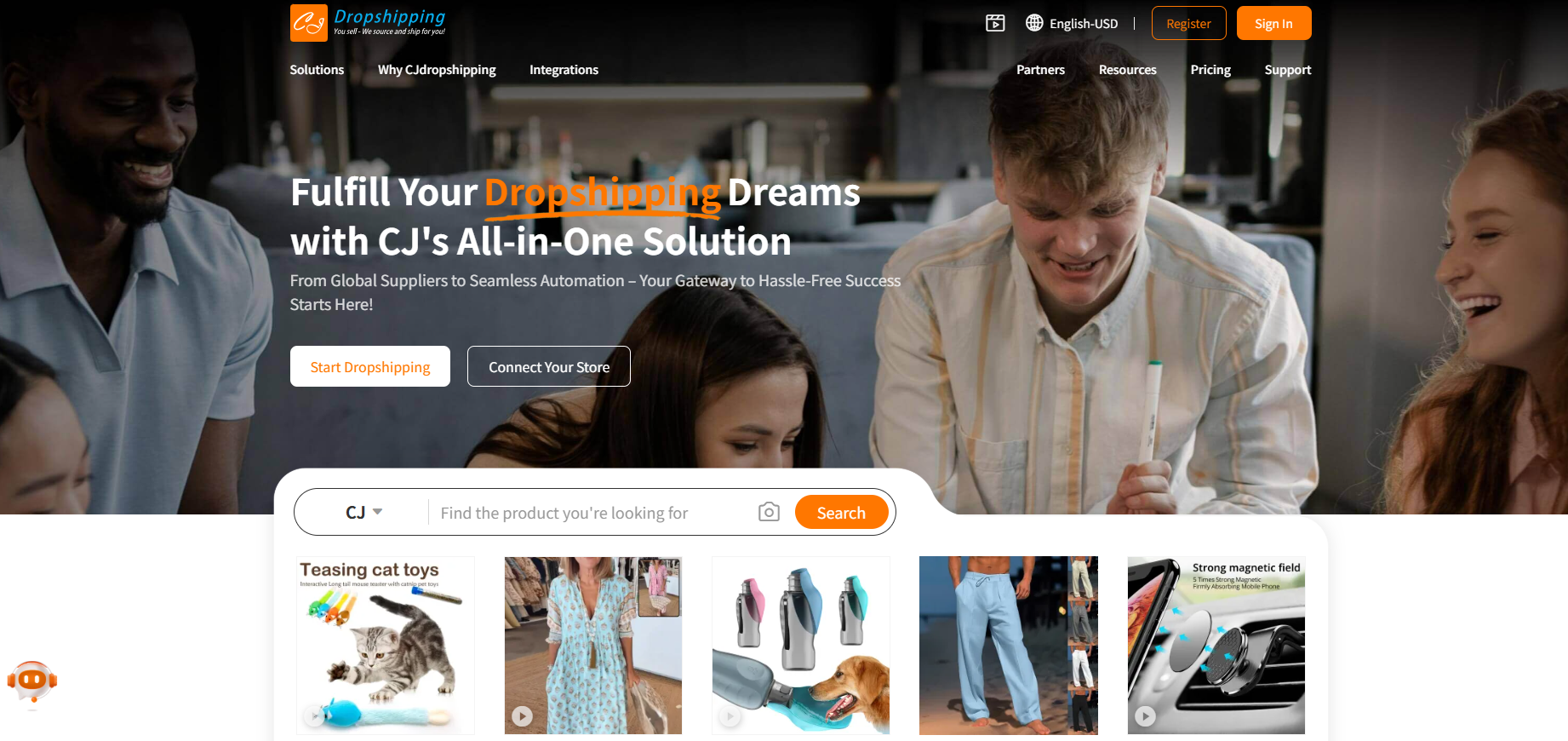
CJ Dropshipping is a full-service dropshipping platform that originates from China but has multiple warehouses across Europe, including in Germany. CJ stands out for its massive product catalog (millions of items similar to AliExpress) and a focus on trending products. It’s essentially a one-stop solution: you can source products (they even handle custom sourcing requests), list them to your store, and have CJ fulfill orders on your behalf. The big advantage of CJ is speed and branding: with German and EU warehouses, products can be delivered to German customers in as fast as a few days, often at lower shipping costs than shipping from China. CJ also offers white-label and print-on-demand services, meaning you can sell products with your own branding. In fact, you can purchase custom packaging materials in bulk from CJ and have them use your branded packages for orders – a great way to build your brand’s professionalism. The platform itself is free to use (no subscription fee); you pay only the cost of goods and shipping. CJ provides an app integration for Shopify and other platforms, making it easy to import products and automate order fulfillment. Do note that some CJ products can be slightly pricier than on open marketplaces, but you’re paying for quality control, fast local delivery, and services like quality inspection and custom branding, which are often worth the premium. If you’re looking to combine variety, speed, and branding, CJ Dropshipping is a top choice for Germany.
2. Spocket – Dropshipping Marketplace for EU/US Products
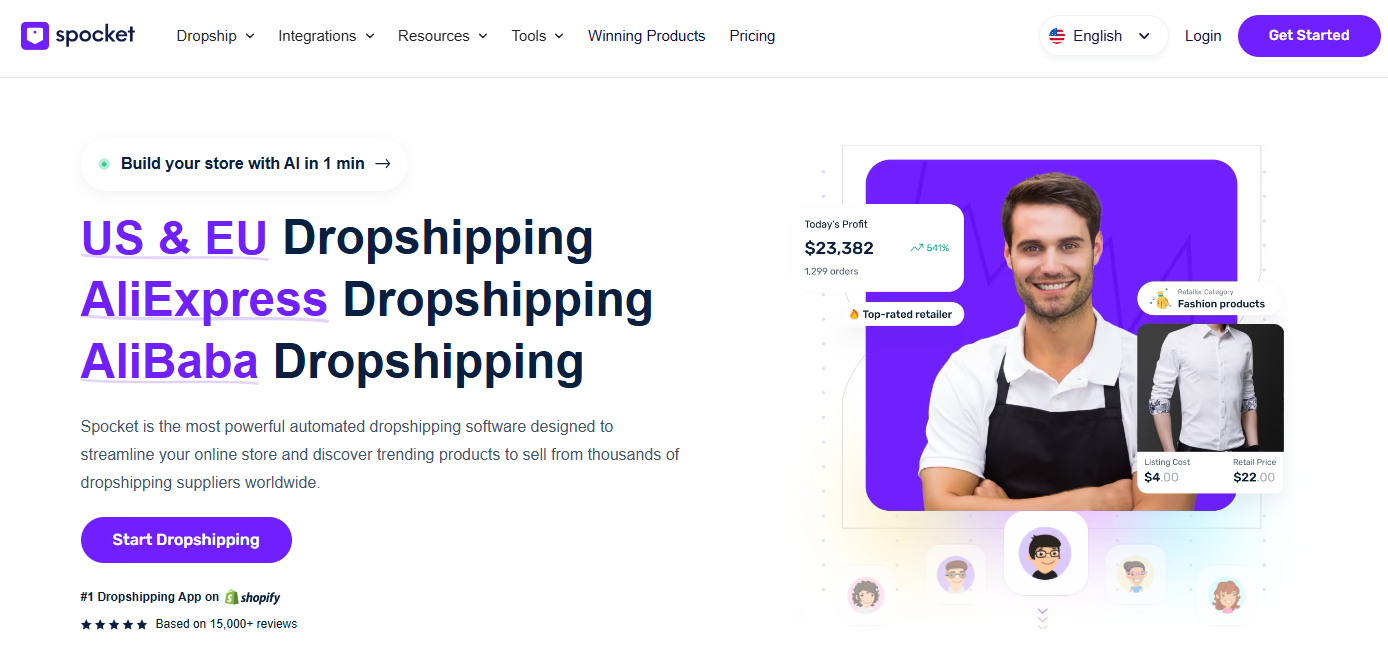
Spocket is a popular dropshipping app/marketplace that connects you with pre-vetted suppliers in the US, UK, EU (including Germany) and more. It’s excellent for running a general online store with a mix of products from various niches. Spocket’s key strength is facilitating fast shipping – many suppliers on Spocket are local to Europe or North America, so shipping times are typically in the 2–5 day range for domestic orders. If you want to avoid dealing with long international shipping, Spocket’s network is a huge benefit. The platform offers a massive catalog of products, effectively acting like a directory where you can find items from multiple dropshipping suppliers in one place. Inventory management is a breeze: Spocket provides real-time stock updates and order tracking, so you know your listings reflect what’s actually available. Another big plus is integration – Spocket easily plugs into Shopify, WooCommerce, BigCommerce, Wix, Squarespace, eBay, Amazon, and more. With one click you can add products to your Shopify store and automate order syncing. Customer support on Spocket is known to be solid as well, which is important when working with multiple suppliers. Spocket has a freemium model: you can browse and even list a few products on the free plan, but to scale up and actually process unlimited orders you’ll need a paid plan (they offer several tiers with a 14-day free trial). Overall, Spocket is reliable and user-friendly, making it one of the best platforms to find EU-based dropshipping suppliers for Germany. It’s especially useful if you want to curate a broad catalog (from fashion to electronics to home goods) while ensuring quick regional delivery.
3. Printify – Print-on-Demand Supplier with German Fulfillment
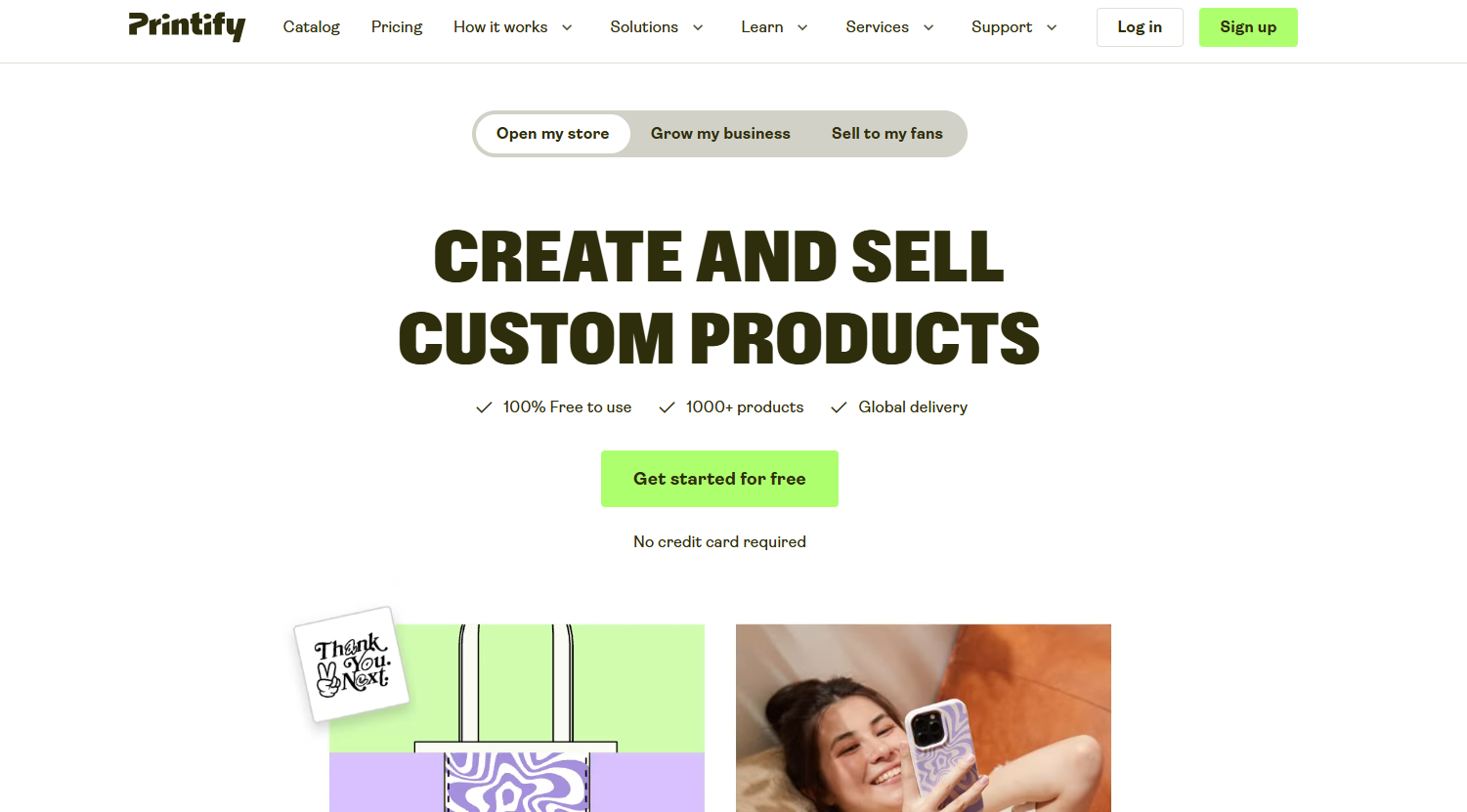
Printify is an all-in-one print-on-demand (POD) platform that’s excellent for dropshippers in Germany who want to sell custom-designed products. With Printify, you can create and sell items like T-shirts, hoodies, mugs, phone cases, home décor and more, without holding any inventory – Printify will handle printing and fulfillment for you. What makes Printify great for Germany is that they partner with print providers globally, including partners based in Germany (and across Europe). This means if you get an order from a German customer, Printify’s network will route it to a German or closest European print facility to produce and ship, resulting in shorter delivery times and lower shipping costs. Printify offers a catalog of 600-800+ customizable products and an easy design tool: you just upload your design or logo on the products using their mock-up generator. The platform is free to sign up and use; you only pay the base cost of products when an order comes in. (They do have an optional Premium plan which gives you a discount on product base costs, useful if you scale up, but it’s not required for basic use.) Integration is another strong suit – Printify connects seamlessly with Shopify, Etsy, WooCommerce, eBay and other major platforms. When an order is placed on your store, it can automatically flow to Printify for fulfillment. The transparency is also great: you can choose which print partner will fulfill each product (some might be in Germany, some in other EU countries or the US), so you have control over balancing cost vs. shipping speed. Because of its ease of use and local production options, Printify is arguably one of the best POD solutions for dropshippers in Germany. It allows you to offer unique, branded products (like custom apparel) with relatively fast domestic shipping, all without investing in any printing equipment yourself.
4. Printful – Premium Print-on-Demand with EU Facilities
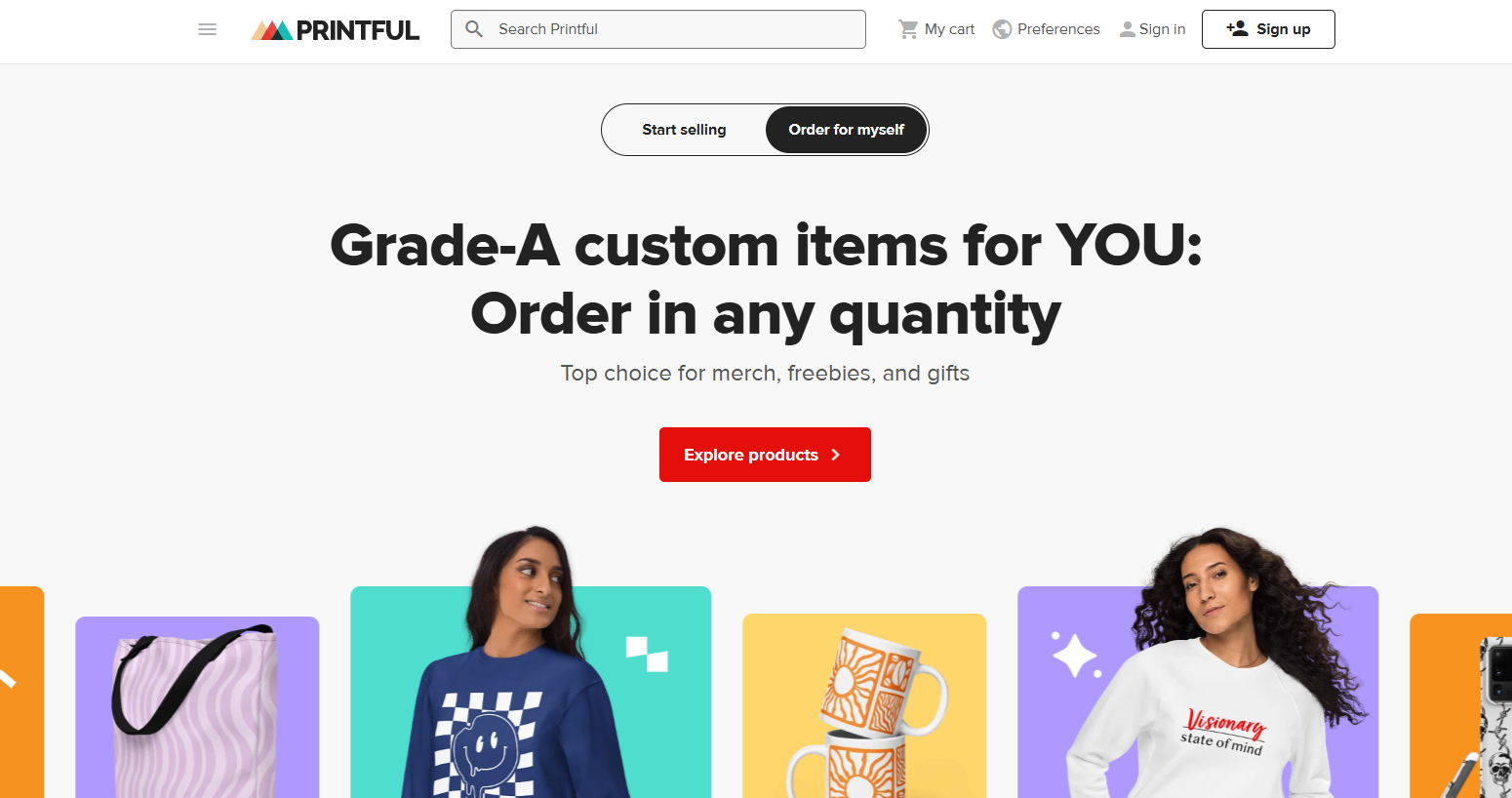
Printful is another leading print-on-demand supplier that’s perfect for building a brand with custom products. Printful is known for its high-quality printing and a wide range of products (apparel, accessories, wall art, etc.). What makes Printful shine for German and European stores is that it operates multiple fulfillment centers in Europe – including facilities in Spain, Latvia, Poland, and the UK. This European footprint means faster production and delivery for your German customers; you can often get orders produced and delivered within a week or less in Europe. Printful also offers awesome branding options: even as a small seller, you can add your logo to labels, include custom pack-ins, and use branded packing slips to give customers the feel of a dedicated brand store. Essentially, Printful helps make a one-person dropshipping operation look like a professional retail brand. There’s no upfront cost or monthly fee to use Printful – they charge per product fulfilled, so the base prices are a bit higher than buying blank products wholesale, but you’re paying for on-demand production and quality service. You’ll need to price your items with a healthy margin to cover that, but customers are often willing to pay a bit more for unique, customized goods. Printful integrates directly with Shopify (as well as WooCommerce, BigCommerce, Wix, Squarespace, Etsy, etc.), so adding products and automating orders is straightforward. In summary, Printful is ideal if you plan to sell custom-branded merchandise in Europe – you get fast local fulfillment and top-notch print quality. Just be mindful of the product costs; with smart pricing and a focus on brand quality, Printful can help you build a loyal customer base.
5. BrandsGateway – Luxury Fashion Dropshipping Supplier

BrandsGateway is a supplier specializing in luxury designer fashion, making it perfect if you want to run a high-end online boutique. It’s actually one of the largest luxury drop ship suppliers online, offering over 15,000 products from 120+ authentic designer brands (think Gucci, Balenciaga, Versace, and the like). For the German market – where fashion is a leading e-commerce segment – this could be a lucrative niche. BrandsGateway is based in Europe (with headquarters in Sweden and warehouses in Europe), so all products are shipped from within the EU. They promise shipping times of 1–3 days within the EU (and about up to 7 days internationally) for orders, which means your German customers can get their luxury items very quickly. They also have a solid 14-day return policy on dropship orders, adding peace of mind for you and your buyers. Some key features: BrandsGateway offers automatic integration plugins for platforms like Shopify, WooCommerce, Wix, etc., so you can sync products, stock, and orders easily. They impose no minimum order quantity (MOQ), which is great – you can sell one item at a time without bulk purchasing. Moreover, the discounts are huge: as a dropshipper, you can get up to 90% off retail prices on their catalog, which leaves room for healthy profit margins (luxury goods often have 2-3x markup potential). One thing to note: BrandsGateway typically requires you to sign up for a dropshipping program (with a membership fee) to access their full feed and integration – this is an investment aimed at serious sellers, but if you plan to sell luxury fashion, the credibility and product range they provide can be worth it. In essence, BrandsGateway lets you offer real high-end fashion items with fast EU shipping, without having to source fake replicas or hold expensive inventory. If you want to tap into the affluent segment of German shoppers, this supplier is a top contender for quality and service.
6. SaleHoo – Directory of Vetted Suppliers (Global & EU)
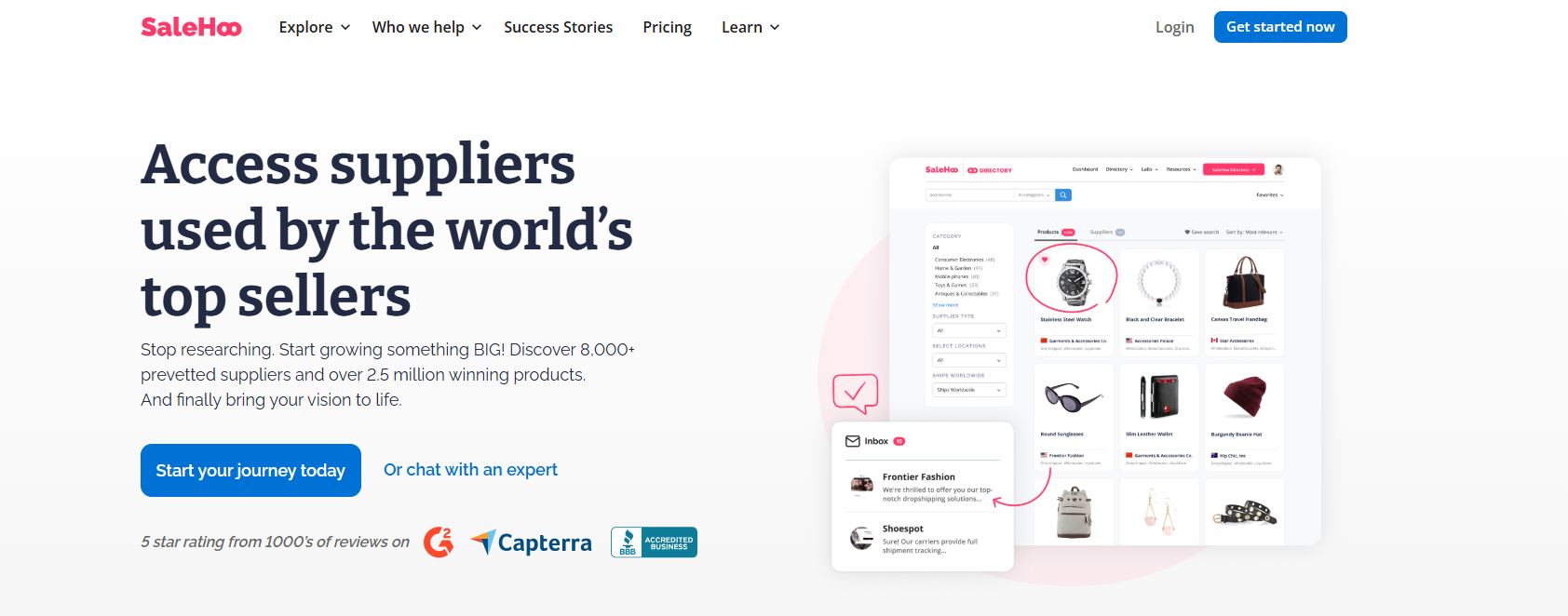
SaleHoo is a bit different from other entries on this list – it’s not a single supplier but rather a comprehensive directory of over 8,000 wholesale and dropshipping suppliers. Think of SaleHoo as a research tool to find reliable suppliers for virtually any product niche. It originated in New Zealand and has a strong reputation in the e-commerce community for vetting suppliers (so you don’t end up dealing with scams). For someone targeting Germany, SaleHoo can be useful because it includes many European suppliers, including German-based ones. Through SaleHoo’s online directory, you can search by product type or category and filter suppliers by location, so you could find (for example) a German supplier of organic skincare, or a UK supplier of electronics that ships quickly to Germany, etc. The platform provides details like supplier contact info, product range, minimum order requirements, and reviews. The major benefit of SaleHoo is the sheer variety – over 2 million products are cataloged through their network, from toys and furniture to beauty products and electronics. This allows you to expand your store’s offerings confidently. SaleHoo also recently launched SaleHoo Dropship, a tool that directly integrates with Shopify to import products (primarily from AliExpress suppliers that SaleHoo has vetted for quality). So there are two ways to use SaleHoo: either manually contacting suppliers from the directory (good if you want EU-based wholesale relationships), or using their Shopify app to quickly import curated AliExpress products. SaleHoo is a paid membership service – typically it has an annual fee (around $67) for the directory access, or a monthly fee if you use the Dropship automation tool. The good news is they have no minimum order requirements on the suppliers they list (many are happy to dropship single items for you) and often you won’t have to pay separate supplier vetting or application fees. If you’re serious about product research and want the flexibility to find niche German suppliers that might not be on the big platforms, SaleHoo is a valuable resource. It’s essentially your backstage pass to trustworthy suppliers worldwide, which you can leverage to give your German store unique inventory or faster shipping by choosing closer suppliers.
7. Doba – Aggregated Marketplace with Millions of Products
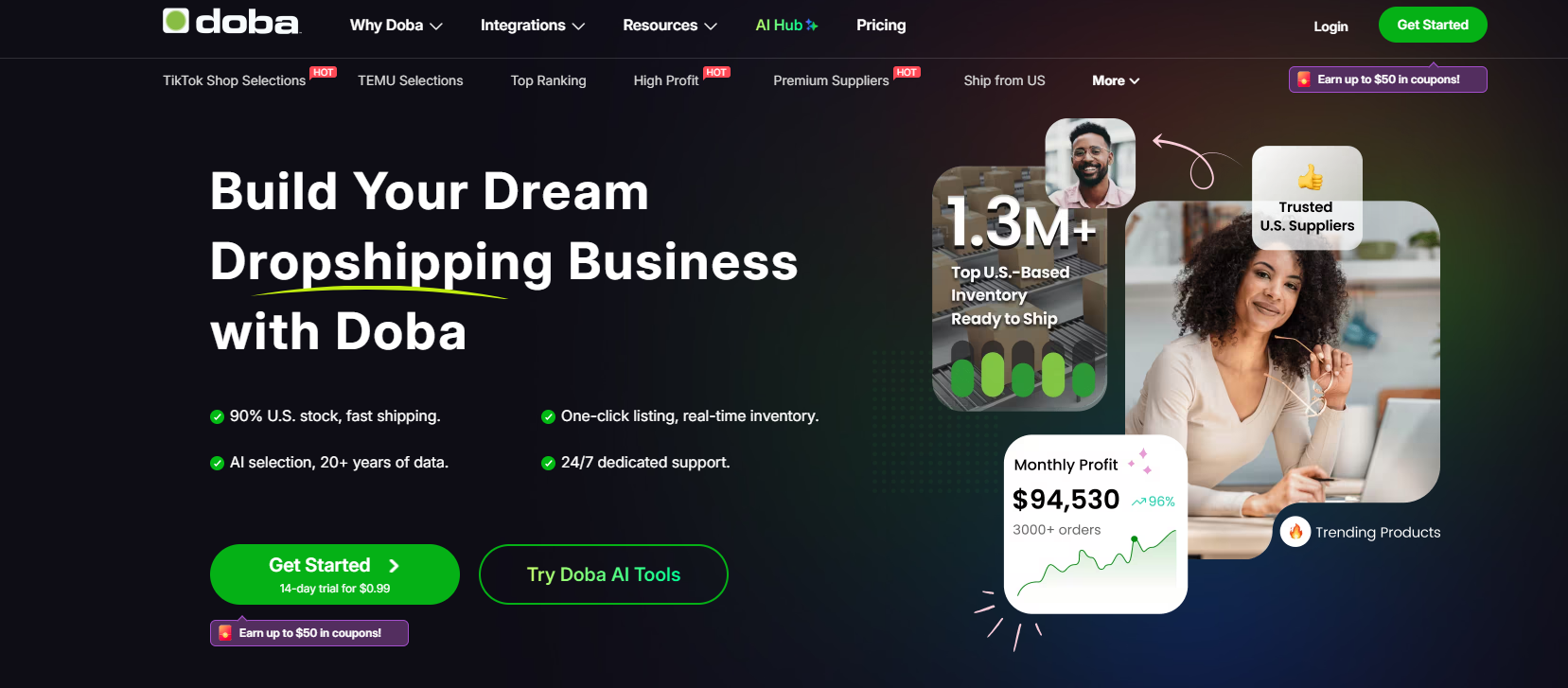
Doba is a dropshipping marketplace and software platform that gives you access to a huge array of products from various suppliers. When you use Doba, you’re tapping into a catalog of millions of products across categories like electronics, apparel, home goods, toys, and more. The suppliers feeding into Doba’s catalog are primarily based in regions like China, Hong Kong, and the U.S.. While only a few are physically located in Germany, Doba still makes our list because it simplifies finding products that can be shipped to Germany and often provides the option to filter for suppliers that ship from (or to) Europe. In practice, you could use Doba to find, say, a particular kitchen gadget and see a list of suppliers offering it – some may have inventory in European warehouses. Doba’s interface consolidates everything: you can place orders to multiple suppliers through one Doba account instead of managing each supplier relationship separately. One advantage of Doba is its integration capabilities – it offers direct integration with Shopify, Amazon, and other platforms so that you can import products to your store and automate order forwarding. This is crucial for efficiency; Doba basically sits in the middle and syncs inventory and tracking info to your store. They also curate a “premium supplier” list which highlights suppliers known for higher quality or unique products, which can help you differentiate your store. Using Doba isn’t free – it operates on a subscription model with plans such as Startup ($24.99/month), Business ($49.99/month), and Enterprise ($299.90/month). The pricing is the same whether you pay monthly or annually, and higher tiers typically allow more product imports and advanced features. For a German dropshipper, Doba can be a good solution if you want a broad product selection and a single control panel to manage orders. It’s especially useful for testing various products quickly. Just keep an eye on where each item ships from – many will ship from China (with ePacket or similar) unless you specifically choose EU-based inventory, but Doba makes it fairly easy to ship to and from Germany by consolidating shipping info and allowing you to forward orders to suppliers with a click. In sum, Doba is about convenience and variety: it brings a huge supplier network to your fingertips, relevant for Germany as long as you leverage its filters and possibly focus on suppliers that can deliver in Europe promptly.
8. AliDropship – AliExpress Solution for Custom Stores
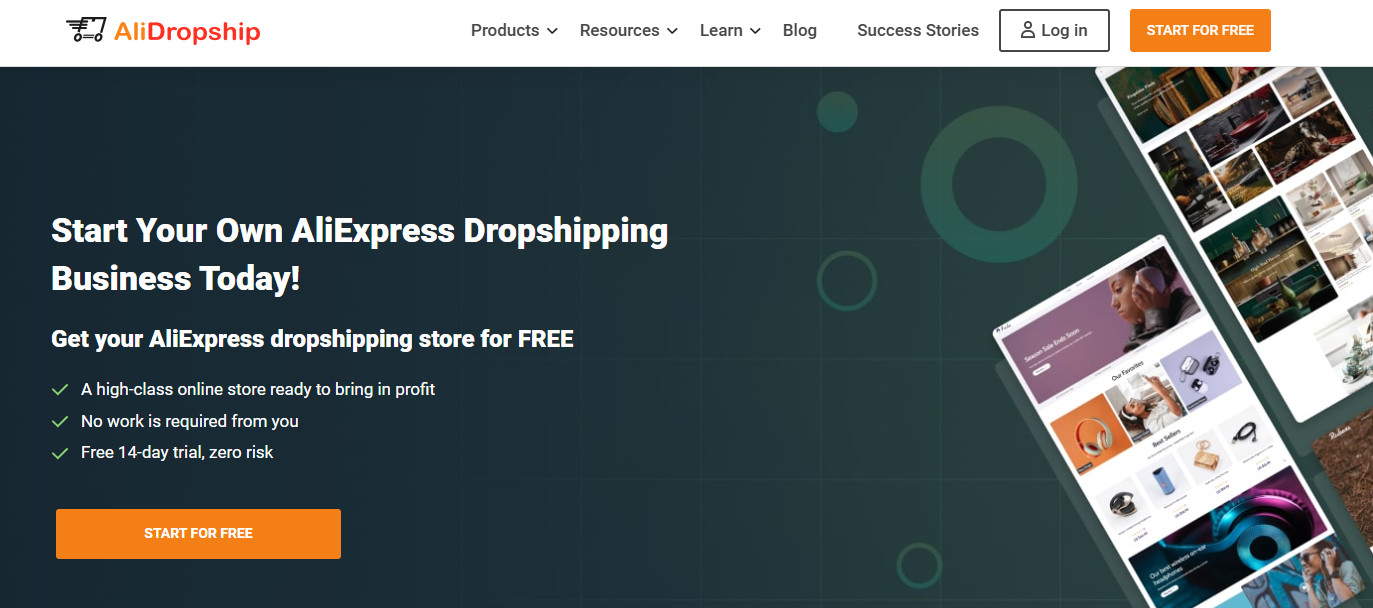
AliDropship is a unique entry in this list. It’s not a supplier or marketplace itself; rather, AliDropship is a WordPress plugin and service that enables you to create your own dropshipping store using AliExpress as the source of products. We include it here because it’s often cited as one of the best solutions for those who want an all-in-one dropshipping setup with lots of control. If your online store is (or will be) on WooCommerce/WordPress, AliDropship can be a game-changer. The plugin lets you import products from AliExpress directly into your WooCommerce store, complete with images, descriptions, and real-time inventory sync. AliExpress, of course, gives you access to millions of products (practically anything you can think of) at low wholesale prices. Many AliExpress sellers now have EU warehouse options for items, which means you could import products that ship from a warehouse in Germany, Spain, or Poland, drastically cutting delivery times to German customers (often to under a week). With AliDropship, you can filter and choose those suppliers or just use Chinese shipping for items that don’t have a local option. The big appeal of AliDropship is ownership and cost: unlike a monthly app, AliDropship is a one-time purchase plugin (roughly $89 for the plugin, or $299 if you want them to build you a custom store from scratch with products). This can save money in the long run, as you’re not paying recurring fees to use the platform. Additionally, AliDropship provides services like web hosting, store themes, and even the option to buy established dropshipping stores from them. Essentially, it’s a comprehensive package for those who prefer WordPress over Shopify. The main thing to consider: AliExpress (and by extension AliDropship) is an indirect supplier – you are still ultimately sourcing from AliExpress vendors. So the shipping times and product quality will depend on those vendors (choose ones with good ratings and, where possible, local warehouses). Transparency is key: since many AliExpress goods are made in China, it’s wise to let customers know about the origin to manage expectations. Many German dropshippers find success using AliDropship by focusing on specific niches and selecting a handful of reliable AliExpress suppliers with good shipping. If done right, AliDropship gives you huge product variety and a lot of autonomy, as if you had your own mini-Amazon store, all for a relatively low one-off cost. It’s best for those who are somewhat tech-savvy (comfortable with WordPress) and want to customize their store extensively while tapping into AliExpress’s vast catalog.
9. Shein (Germany) – Trendy Fashion Source with Local Warehouse
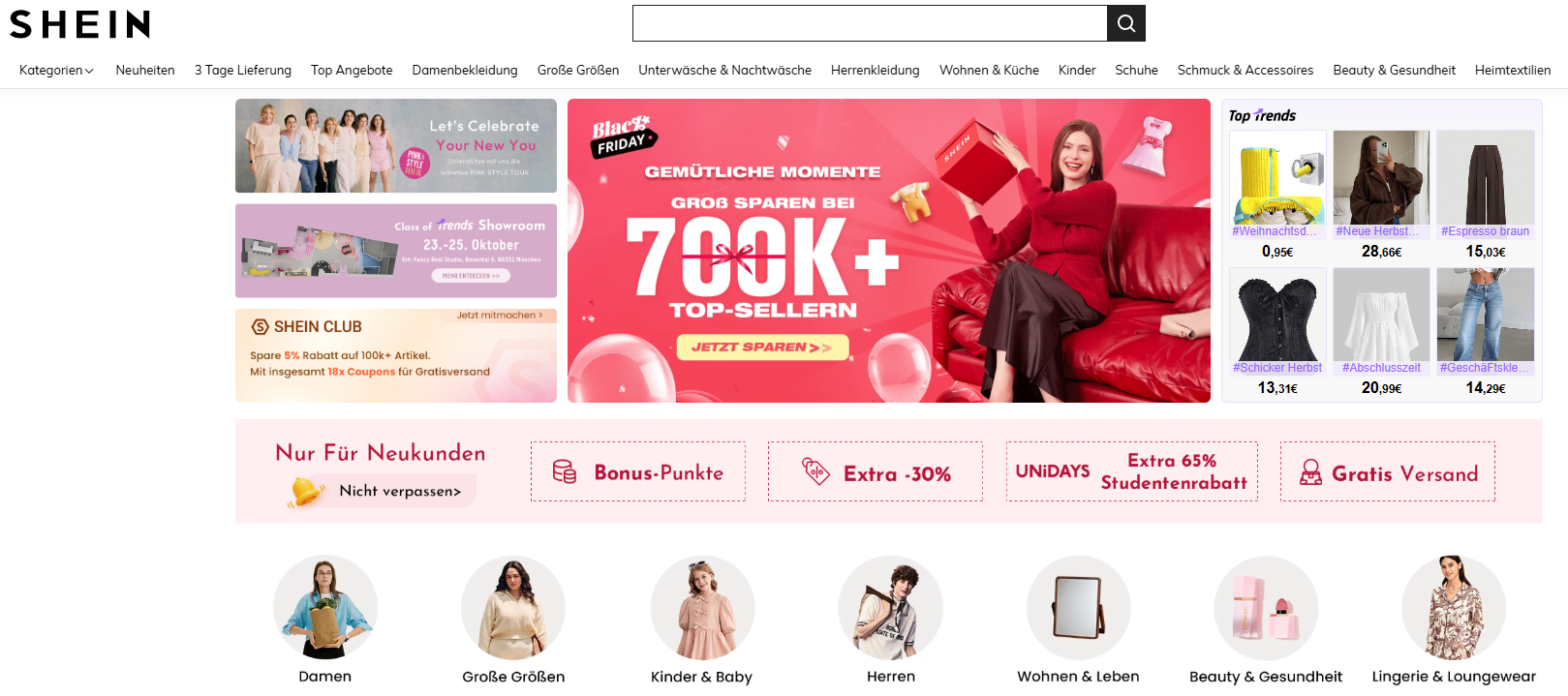
Shein is a famous fast-fashion retailer, not a traditional dropshipping supplier – however, many dropshippers use Shein as a product source, which is why it’s on this list. Shein has a dedicated site for Germany and even warehouses in Germany for fulfillment. If your store is in the fashion/apparel niche, Shein can be a goldmine for affordable, stylish clothing that appeals to a young audience. The biggest advantage of using Shein is that it’s hugely popular – it’s one of the world’s largest fashion e-commerce brands, and in Germany it has a large following. By listing Shein’s products on your own store (with a markup), you’re essentially leveraging their trend-spotting and branding. The products are already attractive to customers, so they tend to sell themselves. Moreover, Shein’s product photography and descriptions are high quality, which means you can often reuse their images and info to create compelling listings (though be cautious of copyright; many people do use them under fair use for reselling purposes). Logistics-wise, Shein offers low-cost shipping within Germany – typically a standard shipping fee around €4.50, and free shipping for orders over €9 (which is practically every order, since most items cost more than €9). They deliver fairly quickly because of the local warehouse, often within 1-2 weeks or sooner for German addresses. Shein also has a 30-day return policy that you can pass on to your customers, making returns easier. Now, integrating Shein isn’t as straightforward as something like CJ or Spocket (since Shein doesn’t have an official dropship program). But there are third-party Shopify apps (such as “ShionImporter” or others) that let you import Shein products and sync inventory. Alternatively, you can manually list products and order from Shein when you get a sale. Keep in mind the ethical side: some customers might recognize Shein products (due to their branding or popularity), so it’s good to rebrand the items to your own store and provide great customer service as your added value. In summary, Shein Germany is an excellent source for trendy, low-cost fashion items with the perk of local shipping. It can boost your store’s appeal to fashion-conscious German shoppers, as long as you handle the integration and rebranding carefully. Many dropshippers successfully use Shein to supplement their fashion inventory because of the huge audience and fast-moving catalog of styles.
10. AppScenic – Premium Supplier Network with EU Focus
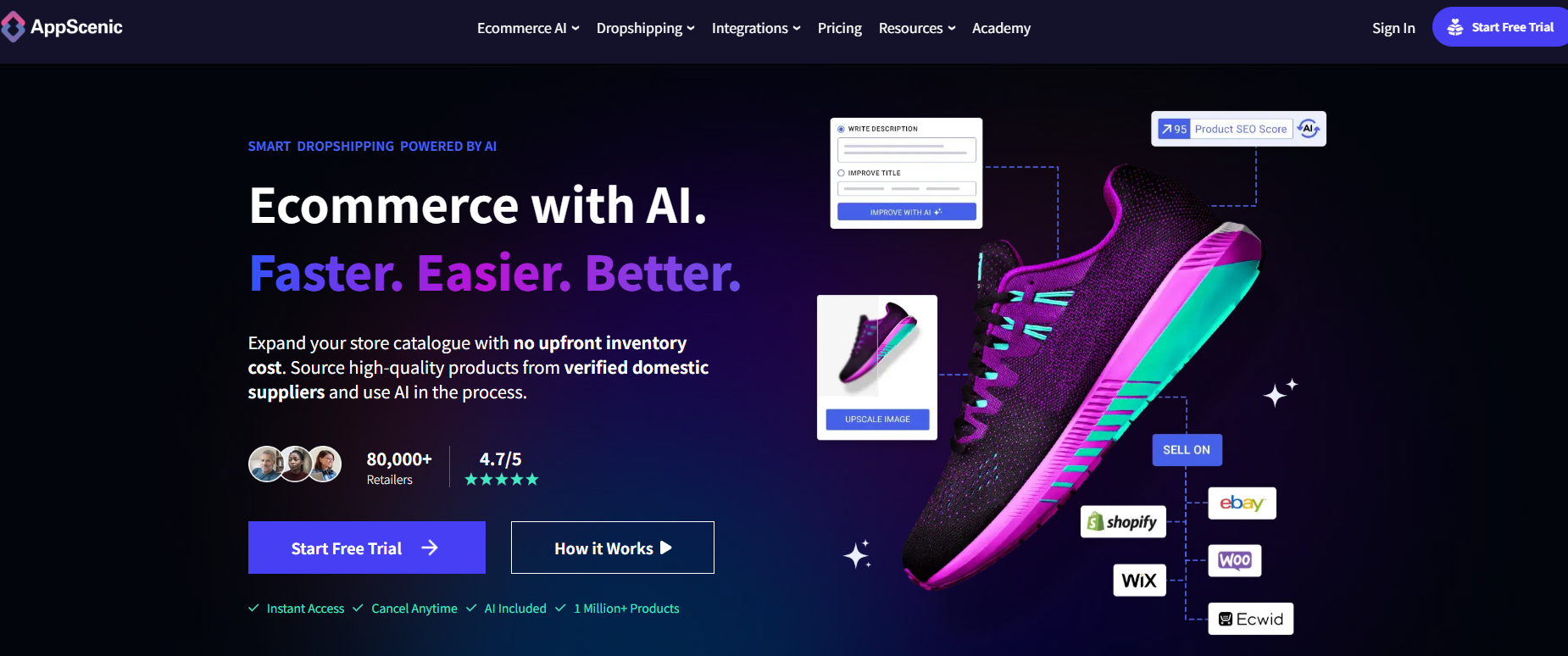
AppScenic is a newer but rapidly growing dropshipping platform that connects store owners with high-quality suppliers, particularly in the EU, UK, and US. It’s gaining attention for having a large catalog and a modern, user-friendly interface. AppScenic is notable for niches like home decor and furniture, among others. In fact, it’s an excellent choice if you want to specialize in furniture or home goods, as they have a strong selection there (which is great because furniture is one of the top-selling categories in Germany’s e-commerce). AppScenic boasts over one million products across various categories, and crucially, many of these products are stored in Germany and other parts of Europe. This allows for fast shipping – often 2-5 days delivery within Europe (and to the US), which is impressive for bulky items like furniture. AppScenic operates as a white-label dropshipping service, meaning when your customer orders, the products ship with no supplier branding (just like most dropship setups). They have plans to offer even more customization, like branded packaging, in the future. Integration is straightforward: AppScenic provides plugins/apps to integrate with Shopify, WooCommerce, Wix, Amazon, eBay, etc., so you can import products and sync orders easily. Essentially, it covers all the major platforms, making it flexible no matter where you host your store. To use AppScenic, you’ll subscribe to one of their plans (they have monthly subscriptions similar to Spocket’s model). The platform is designed to ensure you’re getting quality suppliers – they often list suppliers who might not be on AliExpress or other common marketplaces, which means you can find unique products that aren’t saturated in the market. If, for example, you want a cool Scandinavian-style sofa from a German distributor, AppScenic might have that, and you can offer it with quick shipping instead of relying on an AliExpress equivalent that takes weeks. In summary, AppScenic is a powerful option for premium products and fast EU shipping. It’s ideal for store owners targeting Germany who want to stand out with quality (e.g., selling higher-end home goods, trendy furniture, or specialty items) and who value a platform that seamlessly ties into their e-commerce system. As a newer platform, it’s one to watch – many dropshippers in 2025 are adding AppScenic to their toolkit for the reliable European suppliers and speedy fulfillment it provides.
Now that we’ve introduced the top 10 suppliers, the table below provides a quick comparison of key metrics for each, so you can see at a glance how they differ in focus, shipping, and cost.
Comparison Table: Key Metrics for the Top 10 Suppliers
| Supplier | Product/Niche Focus | EU/German Warehouse | Typical Shipping Time (to DE) | Costs/Integration |
|---|---|---|---|---|
| CJ Dropshipping | General merchandise (all niches); trending products; also POD & custom branding | Yes – multiple EU warehouses (DE, FR, IT, etc.) | ~3–7 days in EU (fast local dispatch) | Free to use; Shopify app & API integration for automation |
| Spocket | General marketplace (varied niches via EU/US suppliers) | Yes – connects to EU & UK suppliers | 2–5 days (if supplier is in EU/UK, fast domestic shipping) | Freemium (free browse, paid plans to sell); Native Shopify app, easy integration |
| Printify | Print-on-demand (apparel, accessories, home decor – ~800 products) | Yes – network of print partners in Germany & Europe | 3–7 days (production + local shipping within EU) | Free base plan (premium optional); Direct integration with Shopify, Etsy, etc. |
| Printful | Print-on-demand (high-quality apparel, merch, etc.) | Yes – own facilities in ES, LV, PL, UK | ~1 week (includes production, ships from within EU) | No monthly fee (pay per product); Shopify integration and custom branding tools available |
| BrandsGateway | Luxury fashion (designer clothing & accessories) | Yes – EU-based fulfillment (ships from Europe) | 1–3 days within EU | Dropship program membership required (no MOQ); Plugins for Shopify/WooCommerce for automation |
| SaleHoo | Supplier directory (8,000+ suppliers, 2M products in many categories) | Many EU suppliers listed (including Germany) | Varies by chosen supplier (can pick local EU suppliers for 2–7 day shipping) | Paid membership (annual or monthly); SaleHoo Dropship app for Shopify available for automation |
| Doba | Aggregator marketplace (electronics, apparel, toys, etc. – millions of items) | Few in Germany (mostly CN/US suppliers, but ships to DE) | Varies by supplier (some items ship from EU/US in ~1 week; others from CN in 2–3 weeks) | Subscription plans ($24.99+ per month); Shopify app integration, centralized order management |
| AliDropship | AliExpress plugin (all AliExpress product categories) | Some AliExpress suppliers have EU warehouses | Varies by product (3–7 days via AliExpress EU warehouse; 2–4 weeks from China) | One-time cost: Plugin $89 (WooCommerce); Not for Shopify (WordPress only). No ongoing fees; manual integration to WP sites |
| Shein (Germany) | Fast-fashion apparel and accessories (women/men/kids) | Yes – Shein has warehouse in Germany | ~5–10 days within Germany (free shipping ≥€9 order) | No direct program (act as retail source); third-party Shopify importer apps available; no extra fees (you purchase items as needed) |
| AppScenic | Curated supplier network (strong in furniture, home, also general products) | Yes – many products stocked in DE/EU warehouses | 2–5 days in Europe (fast shipping to DE) | Subscription-based platform; Shopify/Wix/Amazon integrations; automation and sync included |
Table: Comparison of top German dropshipping suppliers on key factors like niche focus, local warehousing, shipping speed, and costs. Each of these suppliers brings something unique – whether it’s a huge product range, specialty in a niche, or logistical advantages.
What are the Most Popular Dropshipping Products in Germany?
Success in dropshipping partly comes down to selling the right products. Germany has a broad consumer market, but certain categories consistently perform well online. Here are some of the most popular and profitable product niches for dropshipping in Germany (as of 2025):
-
Fashion and Apparel: Clothing and accessories are huge in Germany’s e-commerce. The fashion segment leads in revenue – profits were expected to hit around $22 billion by the end of 2024. Germans buy a lot of apparel online, from everyday wear to sportswear and luxury fashion. For example, high-quality athleisure and sportswear are very popular, given Germany’s sporty culture. If you’re in fashion, consider offering trendy items and even local styles. Note: competition is high, but with the right niche (e.g. sustainable fashion or plus-size clothing) you can stand out.

-
Electronics and Tech Gadgets: Germany’s tech-savvy population loves electronics. Consumer electronics, smartphones and accessories, smart home devices, and wearables are perennial favorites. New gadgets (like the latest smartwatch or wireless earbuds) can sell very well. Just keep in mind that tech moves fast – products can become outdated quickly, and customers might expect warranties or support. Working with reputable suppliers for electronics is key, and offering well-described, quality gadgets will attract the German tech enthusiasts.
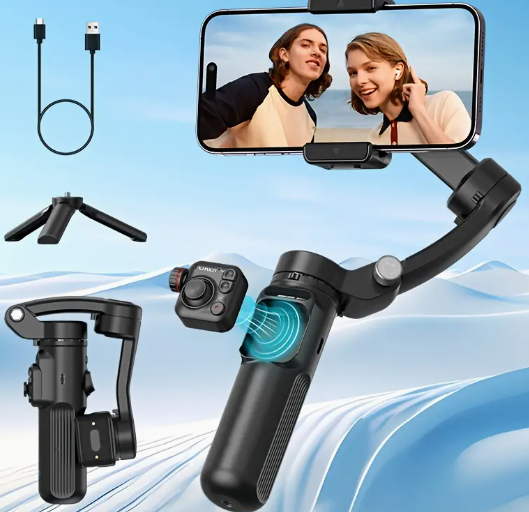
-
Beauty and Personal Care: The beauty and wellness sector is growing in Germany, especially with a shift towards organic and natural products. Skincare, cosmetics, haircare, and health supplements are in demand. German consumers value quality and often look for EU-made or eco-friendly ingredients. Dropshipping items like vegan skincare, grooming products, or even high-end perfumes can be profitable (note that perfumes and cosmetics from known brands might require authorization – or you source from wholesalers like BTS Wholesaler or Perfume distributors in the EU). Also be aware of regulations: for example, health supplements must comply with EU laws and you shouldn’t make unproven health claims.
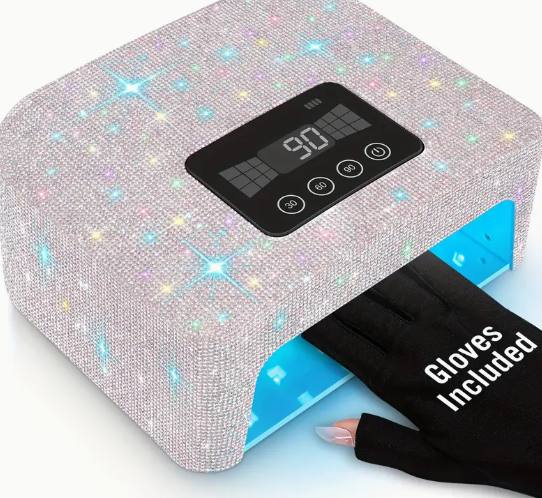
-
Home and Living (Furniture & Décor): Home décor and furniture have seen a boom as more people shop online for their homes. In Germany, furniture, home accessories, kitchen gadgets, and even DIY tools are strong categories. The rise of work-from-home has also increased demand for home office furniture and organization products. Dropshipping bulky items can be challenging due to shipping costs, but if you use a supplier with a German/EU warehouse (like AppScenic or VidaXL), you can offer large items with local delivery. Keep an eye on style trends – e.g., Scandinavian minimalistic design and eco-friendly materials are quite popular in Europe. And ensure your supplier has good packaging for fragile items to avoid high return rates.

-
Toys and Hobbies: The toys, hobbies, and collectibles niche is another lucrative area. This includes everything from children’s toys (which are often bought by German parents online) to hobbyist items like model kits, board games, and crafting supplies. Educational toys, STEM kits, and trendy toys (like whatever is the hit kids’ show merchandise of the year) can do very well. Germany also has a strong board game culture, so selling popular board or card games could be fruitful. Ensure any toys you sell meet EU safety standards (CE certification), which reputable suppliers will adhere to.

-
DIY & Hardware: Many Germans enjoy DIY projects and gardening. Tools, hardware, and gardening supplies see steady demand. While you might not dropship heavy power tools easily, smaller DIY gadgets, car accessories, or home improvement aids can sell in decent volume. Also, outdoor gear (camping, biking, etc.) ties into this category and is popular given the emphasis on outdoor activities in Germany.
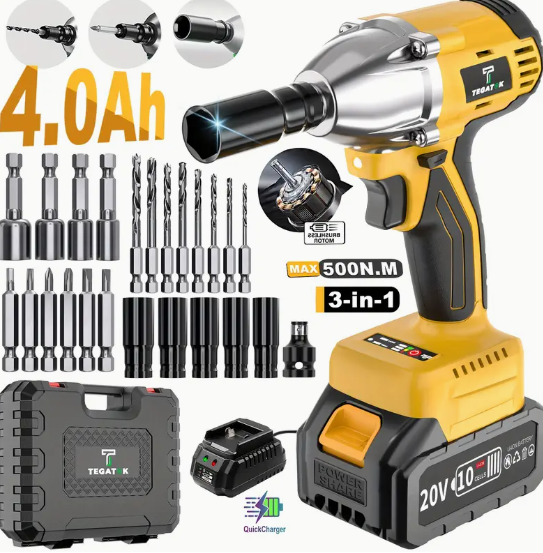
-
Pet Supplies: Pet ownership in Germany is high, and pet owners are often willing to spend on their furry friends. Pet toys, grooming products, pet tech (like automatic feeders or GPS collars), and stylish pet accessories are trending items. If you tap into the pet niche, focusing on quality and safety (non-toxic materials, durable toys) will win trust. Pet supplements and food require careful compliance with regulations, so those are best sourced from German/EU suppliers if you go that route.

-
Food & Organic Products: While dropshipping food can be tricky (due to expiration and shipping conditions), there’s a rising interest in specialty foods, vitamins, and organic products in Germany. Food supplements, vegan snacks, coffee, tea, and organic condiments might work if you have a reliable supplier like buxtrade (which specializes in food additives/supplements). Ensure any edible products comply with EU food safety standards and consider longer shipping times impact. This category might be more niche for dropshipping, but it can build a loyal customer base if done right.

It’s important to note that German consumers value sustainability and quality. A 2025 report indicated about 40% of German shoppers consider sustainability in purchases. This means you could have success with eco-friendly products (reusable household items, sustainable fashion, etc.) and by highlighting environmentally friendly aspects in your marketing.
In practice, before adding any product to your store, do some homework: use tools like Google Trends, Amazon.de bestsellers, or even Statista for Germany to see what’s hot. The above categories are a starting point. The sweet spot is finding a product that’s in demand in Germany but not yet over-saturated with competition. Once you have a candidate, ensure a supplier (preferably in Germany/EU) can dropship it reliably. Remember, the best products to dropship are those that solve a problem or fulfill a strong desire, and that can be delivered to the customer swiftly and in good condition.
How to Integrate These German Suppliers with Your Shopify Store
Finding great suppliers is half the battle – the other half is seamlessly integrating them into your online store so that product importing and order fulfillment are as automated as possible. Fortunately, most of the suppliers we’ve listed offer integrations or can be made to work with Shopify (which is one of the most dropship-friendly e-commerce platforms). Here are steps and tips on integrating the German (and EU-based) suppliers with your Shopify store:
-
Use Official Shopify Apps (When Available): Many major dropshipping services have official apps on the Shopify App Store. For example, Spocket, Doba, and CJ Dropshipping each have a Shopify app you can install. Simply go to the Shopify App Store, search for the supplier name, and you’ll likely find their app. Once installed, you can connect your account and start importing products with one click. These apps handle product data sync (titles, images, inventory counts) and can automatically push orders to the supplier for fulfillment. Using an official app is the easiest and most reliable integration method. For instance, the Doba app allows you to seamlessly connect your store and even uses AI tools to simplify product listing. Similarly, CJ Dropshipping’s app supports product sourcing, auto-listing, and one-click order fulfillment, making the process very convenient.
-
Leverage Platform Integrations and Plugins: Some suppliers offer direct integration through their platform without needing a Shopify-specific app. For example, SaleHoo Dropship provides a web dashboard where you connect your Shopify store by pasting your store URL and API key, after which you can import products directly. AppScenic and BrandsGateway have their own plugins – you would typically get an API key or install a private app to link them. Check the supplier’s website for an “Integration” or “App” section. AppScenic, for instance, integrates into any ecommerce platform by allowing you to generate API credentials; once connected, it will sync products and orders automatically.
-
Use a Dropshipping Management Tool (like AutoDS, DSers, etc.): Another route is to use an intermediary management tool that supports multiple suppliers. AutoDS is one such tool: it can connect to many of the suppliers on our list (like eBay, AliExpress, CJ, etc.) and unify them. You integrate AutoDS with Shopify, and then from AutoDS you can pull in products from various sources. AutoDS will handle stock monitoring and order automation across all suppliers. This is useful if you plan to work with many suppliers and want a single dashboard. Similarly, DSers (an official Shopify partner, successor to Oberlo) is great for AliExpress – it also now supports CJ Dropshipping integration, meaning you can route AliExpress and CJ products through one system. These tools often require a subscription, but they save a lot of manual work and can scale with you.
-
Third-Party Importer Apps for Sites without Official Integration: If a supplier doesn’t have an official integration (like Shein, Amazon, or other retail sources), you can use specialized apps or extensions. For Shein, as mentioned, apps like ShionImporter or Shein Bulk Importer are available. They allow you to import product listings from Shein’s website to your Shopify store in bulk and even sync inventory/prices to some extent. Another example: if you want to dropship from Amazon.de or eBay.de to your Shopify (retail arbitrage model), there are apps and Chrome extensions that can import those listings as well. Use these with caution: ensure you have a plan for fulfilling orders quickly and handling returns. But they can fill in gaps for sources that aren’t natively supported on Shopify.
-
Manual Import via CSV or Oberlo Alternatives: In cases where automation isn’t available, you can always do things the old-fashioned way – import products via CSV files or use a semi-manual app. Many suppliers (like BrandsGateway or SaleHoo directory) allow you to download a CSV data feed of products. You can format this CSV to Shopify’s accepted format and import it in your Shopify admin (under Products > Import). This will create products in bulk. You’ll have to update stock and fulfill orders manually or through email with the supplier in these cases. Alternatively, some use Oberlo-like browser extensions for AliExpress. Since Oberlo is gone, DSers is the recommended tool for AliExpress; it offers one-click import from AliExpress product pages and one-click order fulfillment, similar to how Oberlo worked. It’s not Germany-specific, but if you source some items from AliExpress (especially ones shipping from AliExpress’ EU warehouses), DSers is invaluable.
-
Ensure Inventory Sync and Order Tracking: However you integrate, make sure that your system updates inventory levels and provides tracking numbers back to customers. Most apps will do this automatically (e.g., Spocket and CJ apps will update your Shopify inventory if an item goes out of stock, and insert tracking info when an order is shipped). This is crucial for maintaining a good customer experience. If you’re doing any part manually, set a routine to update inventory weekly and upload tracking promptly.
-
Test the Integration: Before you rely on a supplier integration at full scale, run a few test imports and even place a test order. For instance, add a product from CJ to your store via the app, then purchase it yourself as a test customer. See if the order flows to CJ and if tracking comes back. This helps you catch any setup issues (like an authorization token missing, etc.) early. It’s better to iron out kinks before you have real customer orders.
-
Keep an Eye on Multi-Supplier Challenges: If you use multiple suppliers, you might face a scenario where a customer orders two products that come from two different suppliers in one checkout. Shopify can’t split an order natively, so you’ll need to fulfill each part separately and possibly pay separate shipping costs to each supplier. Plan for this in your shipping strategy (some people build the shipping cost into product prices to offer free shipping and absorb the multi-supplier shipping costs). Also, if you use multiple apps, watch out for any app conflicts. Generally, it’s fine, but manage carefully so you know which app fulfills which product.
Tips for Scaling Your Online Store in Germany Using These Suppliers
After you’ve set up with some great suppliers and started generating sales, the next challenge is scaling your business – growing revenue, orders, and profits in a sustainable way. Germany is a promising market to scale in, but as you grow you’ll need to pay attention to certain factors. Here are some tips for scaling your German dropshipping store effectively:
1. Diversify and Optimize Your Supplier Mix: As your order volume grows, relying on a single supplier for all products can be risky. It’s wise to work with multiple suppliers to mitigate stockouts or shipping delays. For instance, you might source electronics from one supplier and apparel from another. Or even have overlapping suppliers for the same product as backup. Diversifying ensures your business doesn’t grind to a halt if one partner has an issue. However, don’t spread yourself too thin with unreliable sources – stick to the vetted suppliers that have proven good performance. As you scale, you might negotiate better terms (like discounts or faster processing) with your suppliers – don’t hesitate to establish a direct line of communication as you become a “VIP” client for them.
2. Double Down on Best-Sellers and Local Inventory: Keep a close eye on your sales analytics to identify your best-selling products. Once you know what’s working in Germany, focus your marketing and stock availability on those winners. If possible, see if those items can be sourced from a German or EU warehouse (if not already) to ensure the fastest delivery. For example, if a particular kitchen appliance is selling like hotcakes, check if your supplier or an alternate supplier has that item in a German fulfillment center for even quicker shipping. Fast delivery leads to satisfied customers and more positive reviews, which fuel further growth. Some advanced dropshippers even start holding a small inventory of their best-sellers in a German 3PL warehouse once they validate the demand – this hybrid model (some dropshipping, some inventory for hot items) can boost shipping speeds to next-day in some cases. It’s an option to consider when you’re scaling significantly.
3. Invest in Localization and Customer Experience: As you scale in Germany, adapt to the German market more deeply. This could mean translating your store into German (many Germans speak English, but a German-language site will build more trust and expand your reach). Shopify has apps that can help you add German translations. Also, consider providing customer support in German – even if you’re not fluent, you can hire part-time support staff or use translation tools carefully. Localize things like using Euro (€) as the currency, displaying prices with VAT included (common practice in Europe), and being upfront about shipping times in business days. German shoppers appreciate clarity and honesty – if your item ships from Germany in 3 days, shout about that benefit; if it’s shipping from abroad and might take 2 weeks, be transparent on the product page. Building a strong, trustable brand in Germany will set you apart from competitors who might be running generic, foreign-language stores.
4. Scale Your Marketing (While Staying Compliant): With a solid supplier foundation, ramp up your marketing. Use channels that perform well in Germany: for example, Google Shopping ads and Facebook/Instagram ads are commonly used. Also, don’t neglect German comparison shopping sites or marketplaces. Many German shoppers use sites like Idealo.de to compare prices – listing your products there could increase visibility. If you’re comfortable, expand to selling on eBay Germany or Amazon Germany using your dropshipping suppliers (some suppliers like those on Spocket or CJ allow selling on eBay/Amazon). This multi-channel approach can significantly boost sales volume. Just ensure you can handle the operations and that your suppliers can keep up with the increased orders. Remember, more marketing spend will test your backend processes – be ready with those integrations and maybe even virtual assistants to help process orders if needed.
5. Leverage Automation Tools to Handle Volume: Scaling means more orders, more customer inquiries, and more tracking numbers to juggle. To maintain efficiency, lean heavily on automation and tools. We already discussed integration apps – make sure all order syncing is automated. Use an app for sending tracking info to customers automatically, so you’re not manually emailing shipping confirmations. Utilize Shopify’s built-in features like automated fulfillment (if your app supports it) and consider customer service tools (like helpdesk software) to manage the influx of questions. For example, an app like AutoDS can automate price adjustments, stock monitoring, and order fulfillment across many suppliers, which is a lifesaver at scale. Automation reduces errors and frees your time to focus on strategy.
Conclusion
Germany’s thriving e-commerce landscape in 2025 offers tremendous opportunities for dropshippers who are prepared to meet its standards. By partnering with the right suppliers – those that offer quality products, fast local shipping, and easy integration – you position your online store for success in this lucrative market. We’ve covered the 10 best German dropshipping suppliers ranging from global platforms like CJ Dropshipping and Spocket to niche specialists like BrandsGateway and Printful. Each can play a role in building a robust, competitive catalog for your store, whether you focus on fashion, electronics, custom products, or any other hot niche.
The key takeaways: using German or EU-based suppliers can significantly improve your delivery times and customer satisfaction in Germany. In a market known for discerning customers, the ability to provide fast shipping, reliable service, and products that comply with EU quality standards is a huge advantage. Furthermore, leveraging supplier integrations with Shopify will streamline your operations, allowing you to scale without being bogged down in manual tasks.
As you implement these suppliers and strategies, remember that success in dropshipping (or any business) comes from continual learning and adaptation. Monitor what your customers respond to, keep an eye on German market trends, and don’t be afraid to tweak your approach. Perhaps you’ll find that one supplier’s product line resonates especially well – you might build an entire niche store around it. Or you may discover an untapped micro-niche in Germany that you can serve better than anyone else using your network of suppliers.
In conclusion, German dropshipping suppliers can be the backbone of your growing online store, giving you the infrastructure to compete with domestic and international sellers alike. By choosing reputable partners and focusing on quality and customer experience, you’ll be well on your way to building a trusted brand in the German market. Here’s to your success in scaling up your dropshipping venture – viel Erfolg! (much success!)
FAQs — German Dropshipping Suppliers
Q: Is dropshipping legal in Germany?
A: Yes, dropshipping is completely legal in Germany. It’s a recognized retail model. However, you must follow all German and EU regulations that apply to e-commerce.
Q: Why should I use German or EU-based suppliers instead of shipping from China?
A: The main reason is speed and reliability. German/EU-based suppliers stock products within Europe, which means delivery to your German customers in a few days instead of a few weeks. Faster shipping leads to happier customers and fewer complaints or refunds. Local suppliers also handle all import duties and VAT upfront, so your customers won’t get surprise customs bills.
Q: What niches or products are most profitable for dropshipping in Germany?
A: Some of the most profitable niches in Germany include fashion, consumer electronics, home and living, beauty/personal care, toys/hobbies, and pet supplies.
Q: Do German dropshipping suppliers offer faster shipping than suppliers from other countries?
A: Generally yes, if the product is coming from within Germany or nearby in the EU, shipping to German customers will be much faster than, say, shipping from China or the US. German dropshipping suppliers can often deliver within 2–5 business days domestically.
Q: Can I mix multiple suppliers in one Shopify store (and is that okay for German dropshipping)?
A: Absolutely, you can use multiple suppliers in one store – in fact, most dropshippers do this to build a complete product catalog. For example, you might use Printful for your custom merchandise, CJ Dropshipping for gadgets, and a German supplier for home goods, all in the same store. Shopify doesn’t mind multiple suppliers because each product listing can be tagged or routed to whichever fulfillment service or app is responsible.
